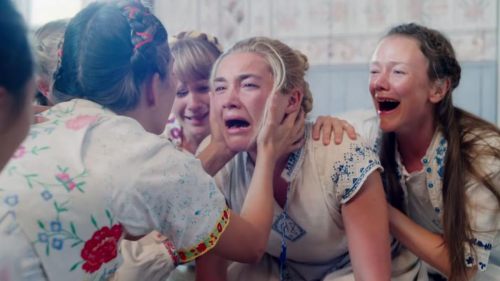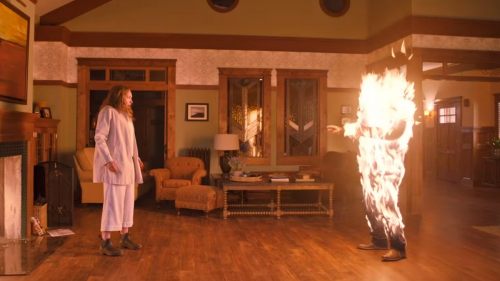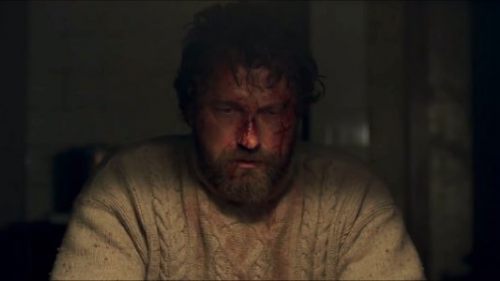Exploitation TV: Volume Eight
For cinephiles, the definition of home video label Vinegar Syndrome’s name is something like a secret handshake. The disease it references consumes celluloid. When film stock starts to degrade, it releases acetic acid, the key ingredient in (you guessed it) vinegar. This phenomenon became a plague during the 80s, chewing up prints of pictures improperly stored in hot, humid conditions. In many cases, where reels of smaller films were scarce due to budgetary restrictions, one bad case of vinegar syndrome could rob the planet of an artist’s work.
According to a ‘12 study conducted by the Library of Congress, only 14% of nearly 11,000 movies made between 1912 and 1930 exist in their original format. Around 70% were lost completely. Coming in at a close second in terms of casualties is the Exploitation Era. This really shouldn’t come as a surprise to anyone, as many of the weirder, more obscure movies made during these decades of disrepute are pictures we’ve probably never heard of in the first place. Thankfully, the Bridgeport, Connecticut boys at VS own a private archive, from which they’ve been pulling and scanning prints of overlooked horror, exploitation and smut cinema from all eras. To make it easier on all us degenerates, they’ve even established a streaming service, where you can log in and watch all the back alley oddities they’ve been uncovering and preserving, so that true vinegar syndrome doesn’t rob us of any more great trash art.
For the eighth edition of Exploitation TV, we spend the night in three haunted houses. Will we make it 'til morning?

The House of Seven Corpses [1974] (d. Paul Harrison, w. Thomas J. Kelly & Paul Harrison)
A strangely chaste Gothic American horror picture (produced in Utah by the Television Corporation of America, which explains its PG approach to scares), The House of Seven Corpses plays like the American recreation of a lost Hammer movie - only they're shooting on grounds where a series of mysterious deaths took place. Once a member of the production crew (Jerry Strickler) retrieves a tattered copy of the Tibetan Book of the Dead from the bowels of this cavernous mansion, and its words are worked into the script of this rather abysmal-looking B-Movie, it doesn't take long for a green faced ghoul to rise from the graveyard out back and start stalking the premises. The whole affair is a rather cheesy, tacky tart of a film, yet still possesses that certain pizazz that was inherent in this particular brand of lo-fi '70s horror.
Though the movie is rather prude in terms of gore or sex (read: there's none at all), that doesn't mean it holds back regarding the social commentary. The domineering director (John Ireland) is constantly at war with this aging leading lady (Faith Domergue), whom he's worked with throughout the whole of both their careers. Knowing she's at the end of her looks, the actress acts out against the tyrannical beast, until he finally snaps and threatens to send her back to the porno sets where he originally found her. It's a sly "text masquerading as subtext" moment, as Paul Harrison's suddenly using this cheap trash art to make a rather blunt commentary regarding how the film industry treats its women. While certainly nowhere near essential, The House of Seven Corpses still contains enough fascinating little nuggets for devoted exploitation archaeologists.

Frightmare (a/k/a Horror Star) [1983] (d. & w. Norman Thaddeus Vane)
Don't let the opening Troma Team title card fool you, Frightmare is a legitimate horror movie. Goofy as shit, and a total product of the neon '80s (just look at the fluorescent tubes in the tomb!), this tale of a Christopher Lee clone (Ferdy Mane) coming back to life to exact psychic vengeance on the film club kids (including a pre-Re-animator Jeffrey Combs) who stole his body following the most lavish funeral of all time is delightfully silly. The kills escalate from simple telekinesis tomfoolery, to full-on gory decapitations. Norman Thaddeus Vane (Lola ['70]) is having the time of his life stringing the strange scare pieces together, as the faux horror star floats through a poster-laden dorm (which is really one hell of a set), looking for his next victim.
Like Return of the Living Dead ('85) or Night of the Demons ('88), Frightmare is a great party movie, celebrating the unusual ways its collection of New Wave cinephiles are just looking to have fun. But it also never lets them off the hook for their more unusual crimes against the dead, allowing the deceased actor's widow to resurrect his corpse via some of the most outlandish black magic (involving a giant crystal pyramid) to grace a screen. Wise enough not to outstay its welcome, Frightmare is 88 minutes of bizarre Halloween fun, blowing up coffins and tearing out tongues like both are going out of style.

Fright House [1989] (d. & w. Len Anthony)
An alien transmission from another dimension, where Lucio Fulci is from New Jersey and schlock comedian Al Lewis becomes both a voice of reason and possibly the Devil Himself, this hour-long psychotronic trip to Nowheresville, USA is an outlandish work of perverse anti-logic. The movie opens with a scummy bit of softcore heavy petting between its mulleted hero (Paul Borghese) and his distant fiancee (Kit Jones), before launching into a "narrative" that involves a cult of underground female Satan worshippers and a haunted house that's inherited by a fraternity. None of it makes a lick of sense, but it also seems to be the product of a world that's arguably better than our own.
Frat boys fake suicides before breaking out into brief song and dance routines, faces catch on fire following bizarre rituals, a weird imp demon dog foams at the mouth while its master carries on a four page monologue about the End of Days. Len Anthony only directed three movies (along with Murderous Intent ['85] and Vampires ['87]) and Fright House is arguably the most linear of them all. Technically, it's only half a picture, originally intended as part of a duology - with a second story called Abandon, starring Night of the Living Dead ('68) protag Duane Jones and revolving around a teacher who can't age - it's tough to imagine ingesting any more psyche-shattering weirdness once this abruptly ends. Fright House is unlike anything you'll ever see, mostly because it feels like a nervous fever dream from a singular diseased mind.
Tune in next week for three more picks from your new favorite channel. In the meantime, log in to Vinegar Syndrome’s streaming service to embark upon your own filthy adventures.



